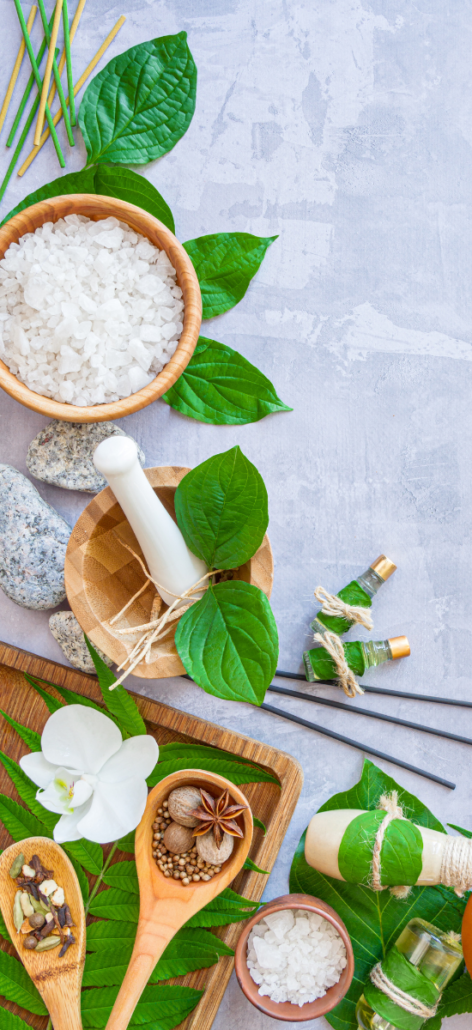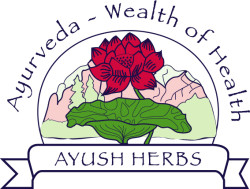An Ayurvedic perspective on Menopause
Menopause is the golden age for women. It is the time when the body has yet another transformation into a powerful state. It is a natural process that occurs in women around the age of 50, though it may occur as early as 40 years or as late as 60 years old. Many women ease into menopause, but many of our sisters struggle with the change. Preparing the body for the transition will ease the time feeling unwell and increase the time feeling beautiful.
During menopause, the ovaries stop producing estrogen and progesterone, halting the menstruation cycle. Estrogen is a hormone that speaks to the brain, cardiovascular tissues, liver, breast tissue, bone tissues, as well as the reproductive tract. It is no wonder why menopause presents symptoms such as irregular periods, hot flashes, libido changes, vaginal dryness, insomnia, mood changes, osteoporosis, weight gain, depression, as well as the increase in symptoms from other disorders such as diabetes, depressive disorders or anxiety. Furthermore, estrogen communication problems may be exacerbated by an unhealthy diet, lack of exercise, excessive alcohol abuse, lack of sleep, and smoking.
In Ayurveda, this is a transition into the Vata stage of life. The body feels dryer and rougher and may start to feel lighter. However, menopause can imbalance all the doshas, presenting the constellation of symptoms described above. Estrogen is a pitta hormone, communicating and transforming tissues whereas progesterone is a Kapha hormone that suddenly dissipates, leaving the body without the lubrication as well as the solid structure that Vata uses to travel and pitta uses to transform within the body.
Estrogen directly influences the thyroid. The Agni (or digestive fire) of the thyroid is weakened with the decrease in estrogen hormone. This organ Agni is one of the most important fires in the body. Metabolism slows down and general body communication becomes sluggish. Weight gain and slow liver metabolism (the increase in blood lipids) is due to the change in the thyroid Agni.
Ayurvedically, treating the symptoms of menopause starts with a whole foods diet. Foods rich in phytoestrogens (plant-based estrogens) balance the estrogen deficit in the female body. Tofu, tempeh, and soybeans are excellent sources of phytoestrogen and are delicious sources of clean protein. Women who have hypothyroid issues should consult their physician before consuming a lot of soy products. Nuts and seeds provide safe and well balanced essential fatty acids, promoting the healthy regulation of inflammation and supporting the nervous system. Furthermore, nuts have large amounts of selenium which helps with muscle health as well as fat metabolism. Whole grains such as Indian Basmati rice and quinoa provide fiber and essential micronutrients for energy production. Leafy greens provide nutrients for detoxification and optimize kidney health.
Arugula, kale, collard greens, and spinach are easily found greens that can accompany any meal. Reducing meat consumption not only allows an increase in nutritious vegetables but also reduces the exposure to growth hormones and antibiotic byproducts that are used to raise livestock. Lastly, taking quality fish oil supports the gut, immune and nervous systems. Fish oils and other healthy fats provide lubrication to decrease the dry and cold Vata in the body.
The body’s metabolism changes with menopause. These changes can affect mood, hormone production, and could increase general stress. Getting moderate exercise (the exercise in which it is only slightly difficult to talk during activity) three to five days a week is key to keeping the internal digestive fires strong and avoiding negative changes to the beautiful aging body. Walking, yoga, biking, or swimming are great ways to release endorphins. This release mediates healthy hormone production and relaxes the nervous system.
Strong, aging women tend to forget to rest and get adequate sleep1,2. During this period in life, quality sleep is important to allow the body to reset. Allow yourself to sleep before 11:00 pm and wake before 7:00 am, aiming for about eight hours of sleep. Ensure to have a winding down period before setting the body to rest as well as a wind-up period once awoken. Gentle yoga or breathing practices (such as alternate nostril breathing) before and after bed will settle the mind and body1,3.
Herbs may also alleviate symptoms of menopause. Cissus quadrangularis has estrogenic activity, which reduces hot flashes and helps to strengthen and maintain bone health4–8,9–11. Saraca indica is a uterine sedative that also nurtures ovarian tissue, slowing down the cessation of estrogen and the jarring effects on the body. Cimicifuga racemosa, also known as black cohosh, improves mood and stabilizes estrogen levels. It also decreases the number of hot flash events as well as the severity of those events12–14. Dioscorea villosa is a yam that assists in antioxidant activity as well as provides estrogen metabolites for the body to use for further processes14–17. Terminalia arjuna improves blood circulation, reducing the feeling of cold fingers and toes, and helps maintain healthy blood lipid levels18–21. Coral powder cools hot flashes naturally and provides calcium for bone and muscle health22–25. Lastly, Ayurveda’s premier female tonic Asparagus racemosus is an adaptogen that can be used at any stage of a female’s life. It can reduce anxiety during the change to the gold age, helps with neurotransmitter regulation, and promotes bone health26–28.
Though many things can go into the body to reduce menopause discomfort, some things should be avoided to increase health. Hair products and body cleansers contain chemicals that can alter estrogen signalings such as parabens and sulfates. Furthermore, facial cleansers, toners, and makeup may contain heavy metals for sun protection or weight. Chemicals such as these are not processed by the body yet easily absorbed by the various mucosal surfaces on the face. When using products that are placed on the skin, read the label to make sure the products are without parabens, sulfates, and heavy metals. If the label has something that is completely unreadable, avoid it.
Small but powerful changes can reduce the negative aspects of a beautiful time in life. Many of the details here can be applied to all women and can be practiced with every generation of women in a family.



- Marshall RS, Basilakos A, Williams T, Love-Myers K. Exploring the Benefits of Unilateral Nostril Breathing Practice Post-Stroke: Attention, Language, Spatial Abilities, Depression, and Anxiety. J Altern Complement Med. 2014;20(3):185-194. doi:10.1089/acm.2013.0019.
- Buchanan DT, Landis CA, Hohensee C, et al. Effects of Yoga and Aerobic Exercise on Actigraphic Sleep Parameters in Menopausal Women with Hot Flashes. J Clin Sleep Med. 2017;13(1):11-18. doi:10.5664/jcsm.6376.
- Kennedy SL. Yoga as the “next wave” of therapeutic modalities for treatment of insomnia. Int J Yoga Therap. 2014;24:125-129. doi:10.17761/ijyt.24.1.82wu454283t15wt0.
- Stohs SJ, Ray SD. A review and evaluation of the efficacy and safety of Cissus quadrangularis extracts. 2012;1114(March):1107-1114.
- Muthusami S, Ramachandran I, Krishnamoorthy S, Govindan R, Narasimhan S. Cissus quadrangularis augments IGF system components in human osteoblast-like SaOS-2 cells. Growth Horm IGF Res. 2011;21(6):343-348. doi:10.1016/j.ghir.2011.09.002.
- Shirwaikar A, Khan S, Malini S. Antiosteoporotic effect of ethanol extract of Cissus quadrangularis Linn. on ovariectomized rat. J Ethnopharmacol. 2003;89(2-3):245-250. doi:10.1016/j.jep.2003.08.004.
- Potu BK, Bhat KMR, Rao MS, et al. Petroleum ether extract of Cissus quadrangularis (Linn.) enhances bone marrow mesenchymal stem cell proliferation and facilitates osteoblastogenesis. Clin (Sa?o Paulo, Brazil). 2009;64(10):993-998. doi:10.1590/S1807-59322009001000010.
- Naikwade, N, Mate, G, Chowki, A & Patil B. Evaluation of anti-nociceptive activity of Cissus quadrangularis in albino mice. Int J Green Pharm,. 2008;2(June):118-121.
- Pradhan P, Joseph L, Gupta V, et al. Saraca asoca (Ashoka): A Review. J Chem Pharm Res. 2009;1(1):62-71. www.jocpr.com.
- Viswanatha Swamy AHM, Patel U, Koti B, Gadad P, Patel N, Thippeswamy AHM. Cardioprotective effect of Saraca indica against cyclophosphamide-induced cardiotoxicity in rats: A biochemical, electrocardiographic and histopathological study. Indian J Pharmacol. 2013;45(1):44. doi:10.4103/0253-7613.106434.
- Yadav NK, Saini KS, Hossain Z, et al. Saraca indica Bark Extract Shows In Vitro Antioxidant, Anti-breast Cancer Activity and Does Not Exhibit Toxicological Effects. Oxid Med Cell Longev. 2015;2015:1-15. doi:10.1155/2015/205360.
- Nappi RE, Malavasi B, Brundu B, Facchinetti F. Efficacy of Cimicifuga racemosa on climacteric complaints: A randomized study versus low-dose transdermal estradiol. Gynecol Endocrinol. 2005;20(1):30-35. doi:10.1080/09513590400020922.
- Frei-Kleiner S, Schaffner W, Rahlfs VW, Bodmer C, Birkhäuser M. Cimicifuga racemosa dried ethanolic extract in menopausal disorders: A double-blind placebo-controlled clinical trial. Maturitas. 2005;51(4):397-404. doi:10.1016/j.maturitas.2004.10.003.
- Depypere HT, Comhaire FH. Herbal preparations for the menopause: Beyond isoflavones and black cohosh. Maturitas. 2014;77(2):191-194. doi:10.1016/j.maturitas.2013.11.001.
- Wu WH, Chung CJ, Liu LY, Jou HJ, Wang TA. Estrogenic Effect of Yam Ingestion in Healthy Postmenopausal Women. J Am Coll Nutr. 2005;24(4):235-243. doi:10.1080/07315724.2005.10719470.
- Dong SH, Nikoli? D, Simmler C, et al. Diarylheptanoids from Dioscorea villosa (Wild Yam). J Nat Prod. 2012;75(12):2168-2177. doi:10.1021/np300603z.
- Aumsuwan P, Khan SI, Khan IA, et al. Evaluation of wild yam (Dioscorea villosa) root extract as a potential epigenetic agent in breast cancer cells. Vitr Cell Dev Biol – Anim. 2014;51(1):59-71. doi:10.1007/s11626-014-9807-5.
- Kapoor D, Vijayvergiya R, Dhawan V. Terminalia arjuna in coronary artery disease: Ethnopharmacology, pre-clinical, clinical & safety evaluation. J Ethnopharmacol. 2014;155(2):1029-1045. doi:10.1016/j.jep.2014.06.056.
- Trivedi A, Katti HR, Shalavadi MH, Ramkishan A, Chandrashekhar VM. Anti-osteoporotic activity of ethanol extract of terminalia Arjuna (Roxb.) wight & arn. on ovariectomized rats. Indian J Nat Prod Resour. 2015;6(2):98-105.
- Ragavan B, Krishnakumari S. Effect of T. arjuna stem bark extract on histopathology of liver, kidney, and pancreas of alloxan-induced diabetic rats. African J Biomed Res. 2009;9(3):189-197. doi:10.4314/ajbr.v9i3.48904.
- Viswanatha GL shastry, Vaidya SK, Ramesh C, Krishnadas N, Rangappa S. Antioxidant and antimutagenic activities of bark extract of Terminalia arjuna. Asian Pac J Trop Med. 2010;3(12):965-970. doi:10.1016/S1995-7645(11)60010-2.
- Demers C, Hamdy CR, Corsi K, Chellat F, Tabrizian M, Yahia L. Natural coral exoskeleton as a bone graft substitute: a review. Biomed Mater Eng. 2002;12:15-35.
- Cai L, Wang Q, Gu C, et al. Vascular and micro-environmental influences on MSC-coral hydroxyapatite construct-based bone tissue engineering. Biomaterials. 2011;32(33):8497-8505. doi:10.1016/j.biomaterials.2011.07.087.
- Gao Z, Chen F, Zhang J, et al. Vitalisation of tubular coral scaffolds with cell sheets for regeneration of long bones: a preliminary study in nude mice. Br J Oral Maxillofac Surg. 2009;47(2):116-122. doi:10.1016/j.bjoms.2008.07.199.
- Petite H, Viateau V, Bensaïd W, et al. Tissue-engineered bone regeneration. 2000;18(June 2014):959. doi:10.1038/79449.
- Acharya N, Acharya S, Shah U, Shah R, Hingorani L. A comprehensive analysis on Symplocos racemosa Roxb.: Traditional uses, botany, phytochemistry and pharmacological activities. J Ethnopharmacol. 2016;181:236-251. doi:10.1016/j.jep.2016.01.043.
- Bhutani KK, Jadhav AN, Kalia V. Effect of Symplocos racemosa Roxb. on gonadotropin release in immature female rats and ovarian histology. J Ethnopharmacol. 2004;94(1):197-200. doi:10.1016/j.jep.2004.04.022.
- Saxena V, Mishra G, Saxena A, Vishwakarma KK. A comparative study on quantitative estimation of tannins in Terminalia chebula, Terminalia belerica, Terminalia arjuna and Saraca indica using spectrophotometer. Asian J Pharm Clin Res. 2013;6(SUPPL.3):148-149.
Share:
Related Posts

Goodbye Pie Chart, Hello Phase 1 Sliders
Written by Allison Smith, ND | 2025 As we usher in a new era of DUTCH testing which leaves behind the concept of the three-way

Introducing the DUTCH Dozen
Written by Kelly Ruef, ND | 2025 Hormone testing can be complex, which is why Precision Analytical developed the DUTCH Dozen, an interpretive framework that

DUTCH Report Enhancements
Written by Hilary Miller, ND | 2025 Precision Analytical have released the newest version of the DUTCH Test. This is the report’s most significant update

Gallbladder Health 101: What It Does and How to Keep It Working Well
Written by Ashley Palmer & Pooja Mahtani | 2025 The gallbladder may not get much attention compared to the gut, but it plays a central

Can You Bring Vitamins on a Plane? How To Travel with Supplements
Written by Austin Ruff | 2024 Are you traveling for a work conference, an athletic competition, or a weekend getaway? Just because you’re leaving home

